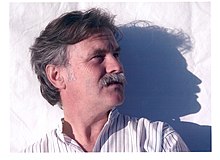Ulrich Stranz
Ulrich Stranz | |
|---|---|
 | |
| Born | 10 May 1946 |
| Died | 27 April 2004 (aged 57) |
| Education | Musikhochschule München |
| Occupations |
|
| Awards |
|
Ulrich Stranz (10 May 1946 – 27 April 2004) was a German teacher and composer.[1]
Life
[edit]
Born in Neumarkt-Sankt Veit, Upper Bavaria,[2] Stranz grew up in Munich, obtaining the Abitur at the Musisches Gymnasium in 1966.[2] He studied composition with Fritz Büchtger from 1965 to 1968, who taught him music theory, forming of melodies (Melodiebildung), counterpoint, and a twelve tone system with esoteric and anthroposophical background.[3] He studied at the Musikhochschule München from 1968 to 1972, violin with Heinz Endres, and Günter Bialas.[2] Bialas initiated a series Musik der Zeit (Contemporary music), which gave Stranz the opportunity of public performances.[3]
Stranz spent two years at the electronic studio in Utrecht, by the German Academic Exchange Service. In 1974, he settled in Zürich, where he worked as a teacher and composer. In 1980/81, he spent half a year on a scholarship at the Villa Massimo in Rome.[2] Stranz died in Zürich shortly before his 58th birthday of cancer. He was buried at the Fluntern Cemetery.
Work
[edit]Compositions by Stranz include orchestral, ensemble and chamber music. His four string quartets became especially famous. His works were published by Bärenreiter Verlag, and recorded by Wergo and telos.[2]
Stranz developed his own musical style during his studies with Bialas.[3] His compositions focus on single tones and single phrases, aiming for a combination of inspiration and construction. He used this intimate approach (Innigkeit dieses Ansatzes) in the orchestral works Tachys (1974), Zeitbiegung (1977), Szenen Nr. 1–3 (three scenes, 1980/82), in his first symphony subtitled Grande Ballade for saxophone quartet and large orchestra, and in two works for piano and orchestra (1978/82 and 1992).[4]
Musik für Klavier und Orchester Nr. 1 was premiered by pianist Margarita Höhenrieder, the symphony orchestra of the Bayerischer Rundfunk, conducted by Cristóbal Halffter, on 25 February 1983 in Munich in the series musica viva.[5]
Awards
[edit]- 1974 Composition Prize of the City of Stuttgart (for Tachys;[6] Musik für zwei Violoncelli und Orchester (1999/2000) together with Horst Lohse, Wolfgang Rihm and Manfred Trojahn)
- 1976 Kranichsteiner Musikpreis in the category composition[7]
- 1980 Villa Massimo[8]
- 1992 Schneider-Schott Music Prize[2]
- 2000 Gerda-und-Günter-Bialas-Preis[2]
References
[edit]- ^ Alastair Williams (18 July 2013). Music in Germany Since 1968. Cambridge University Press. p. 205. ISBN 978-0-521-87759-6.
- ^ a b c d e f g "Ulrich Stranz". Bärenreiter (in German). Retrieved 6 March 2020.
- ^ a b c Gartmann, Thomas (1 March 2005). "Ulrich Stranz – Biogramm". Munzinger (in German). Retrieved 6 March 2020.
- ^ Schulz, Reinhold. "Deutsche Komponisten der Nachkriegszeit". Takt1 (in German). Retrieved 6 March 2020.
- ^ "Stranz, Ulrich / Musik für Klavier und Orchester Nr. 1". Bärenreiter (in German). Retrieved 6 March 2020.
- ^ Tachys für grosses Orchester und Solostreicher (1974) Szenen (Nr. I-III) für Orchester (1980/1982); Erste Sinfonie "Grande Ballade" für solistisches Saxophon-Quartett und grosses Orchester (1989/90) on WorldCat
- ^ "Kranichsteiner Musikpreis Chronologie" (PDF). Darmstadt: Internationales Musikinstitut Darmstadt. Retrieved 13 March 2020.
- ^ "Villa Massimo | Stipendien". Retrieved 28 February 2020.
Further reading
[edit]- Stranz, Ulrich. In Marc Honegger, Günther Massenkeil (ed.): Das große Lexikon der Musik in 8 Bänden. Volume 8, Herder Verlag, Freiburg i.Br. 1982, ISBN 3-451-18058-8, p. 20.
- Thomas Gartmann: Stranz, Ulrich. In Wilhelm Ziehr (Red.): Schweizer Lexikon in 6 Bänden. Volume 6, Verlag Schweizer Lexikon, Lucerne 1993, ISBN 3-9520144-0-0, p. 120.
External links
[edit]- Literature by and about Ulrich Stranz in the German National Library catalogue
- Ulrich Stranz discography at Discogs
- Stranz, Ulrich on the Swiss Nationalphonothek
- Ulrich Stranz Bayerisches Musiker-Lexikon Online
- Ulrich Stranz dream.cs.bath.ac.uk p. 16
